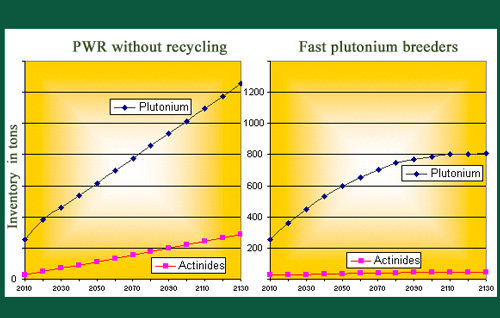The keys to breeding …
Breeder reactors require fast neutrons and a plutonium fuel. To allow breeding, it is necessary that the number of secondary neutrons per fission should be above two, one being required for the maintenance of the chain reaction, another for regenerating a fissile nucleus. A comfortable margin is needed to account for unavoidable losses and leaks.
The condition is only met for plutonium-239 with fast neutrons and uranium-233 with slow and fast neutrons. Uranium-233 fuels are not currently available. The only remaining option is plutonium with fast neutrons. The plutonium-239 generates 2.3 secondary neutrons per capture of fast neutrons, offering a margin of 0.3 neutrons above the theoretical threshold of two required (for slow neutrons this margin falls to 0.11 which is insufficient).
Uranium-235 does not allow itself breeding: the number of neutrons per capture is only 2.07 with slow neutrons (theoretically possible, but the 0.07 margin of 0.07 is insufficient) and 1, 9 with fast neutrons (breeding impossible).

Neutron captures and safety factors
The absence of a moderator ensures the safety of fast neutron reactors with fuels rich in fissile elements. Through hundreds of collisions with uranium-238 nuclei that they undergo during slow down, neutrons are captured before they become slow. The percentage of non-fission captures in uranium-238 is particularly important in the resonance zone below 10 keV. This capture later transforms the nucleus into fissile plutonium-239.
© IN2P3 (Source JANIS)
In a breeder reactor, the plutonium-rich fuel core is surrounded by a fertile uranium blanket so that the fast neutrons that travel through it are captured by a nucleus of uranium-238, which later transforms into plutonium-239, regenerating consequently a fissile nucleus.
Unlike conventional reactors where the art is to avoid captures by uranium nuclei that would thwart the march of the reactor, neutro captures are on the contrary sought for breeding. The breeders do not need a moderator. Thecores heart of these reactors are small and compact. Neutrons slow down as a result of elastic collisions on the heavy nuclei present in the heart. These collisions favor the neutrons captures in the uranium-238 nuclei of the fertile cover.

Reduction of plutonium inventory with fast neutrons breeders
An advantage of fast neutron reactors would be the reduction inventory of plutonium and actinides. On the left, taking the case of a 60 Gigawatts open-cycle park with PWRs without recycling, plutonium and actinides would accumulate at a rate of 13 and 1.5 tonnes per year. On the right, it has been assumed that the same electrical power is provided only by fast breeders. In this hypothetical scenario, plutonium and actinides would be recycled. The inventory of plutonium would stabilize at 800 tons, that of actinides being very small.
© IN2P3 (Source : Clefs CEA)
These captures, which trap the neutrons before they reach thermal energies, also ensure the safety of the reactor. If the neutrons became thermal an explosive chain reaction may develop in a core rich with fissile elements. In fast neutron reactors neutrons are captured before becoming thermal. Such reactors are very safe.
The percentage of fissile plutonium is significantly higher than the uranium-235 percentage in slow neutron reactors. Without this high proportion, fast reactors could not work. Neutron fluxes need to be very intense in order to compensates for the fact that fast neutrons are less easily captured than slow neutrons (much lower cross-sections).